Over the Years
Home > Over the Years > > Conducted a Seminar on Medical Care for A-bomb Survivors in the State of Hawaii, the U.S.
Conducted a Seminar on Medical Care for A-bomb Survivors in the State of Hawaii, the U.S.
Moreover, due to the occurrence of the accident at the Fukushima No. 1 nuclear power plant associated with the Great East Japan Earthquake, people are taking more interest in medical care for radiation-exposed individuals on a global scale.
This year, we conducted a seminar in the State of Hawaii, where we had previously failed to hold a seminar in 2009 when we dispatched a delegation to the U.S. (Los Angeles, Seattle and San Francisco). The seminar was held to promote understanding and diffusion of medical care for A-bomb survivors among local physicians. It also aimed to enhance collaboration with physicians who have played a leading role in the on-site medical care of A-bomb survivors and to establish a more solid framework for cooperation in dispatching local physicians and other medical professionals to HICARE training.
Period:
Members:
| Hiroo Dohy | President of HICARE, President of Hiroshima Red Cross Hospital & Atomic-Bomb Survivors Hospital |
| Kazunori Kodama | Executive Secretary of HICARE, Chief Scientist of Radiation Effects Research Foundation |
| Koichi Tanigawa | Executive Secretary of HICARE, Professor of Hiroshima University |
| Miyuri Fukuhara | Secretariat of HICARE, |
| Toshiaki Hada | Secretariat of HICARE, |
Outline of the Seminar:
(1) Content
・Activities of HICARE: President Dohy
・Effects of Radiation on the Human Body: Executive Secretary Kodama
・Emergency Medical System for the Radiation-Exposed, and the Situation of the Accident at the Fukushima No. 1 Nuclear Power Plant: Executive Secretary Tanigawa
・Relief Administration for A-bomb Survivors Residing Abroad (conducted at a seminar intended for the general public): Secretariat Hada
| Date | Venue | Object person | Participant |
|---|---|---|---|
| February 23 (Thu.) | Kuakini Health System | Physician | Approx. 70 |
JABSOM, University of Hawaii | Medical student | Approx. 40 | |
| February 24 (Fri.) | Hawaii Tokai International College | General public | Approx. 30 |
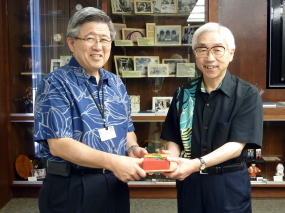
Mr. Kajiwara, President of the Kuakini Health System (left) and President Dohy
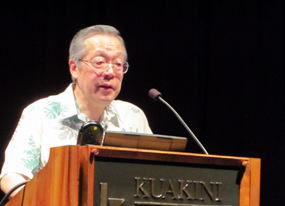
A lecture delivered by Executive Secretary Kodama
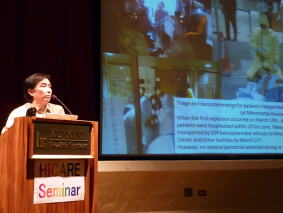
A lecture delivered by Executive Secretary Tanigawa
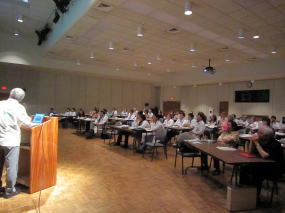
Medical personnel attending a lecture
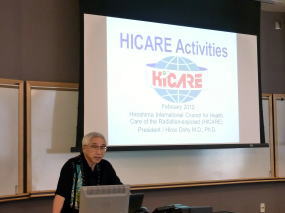
A lecture delivered by President Dohy
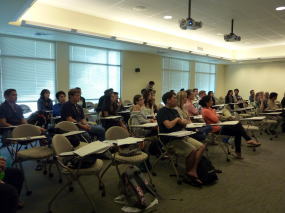
Medical students attending a lecture
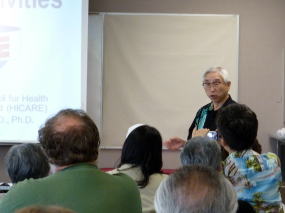
A lecture delivered by President Dohy
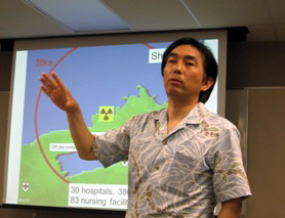
A lecture delivered by Executive Secretary Tanigawa
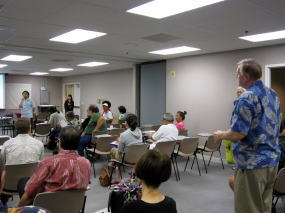
Participants asking a question
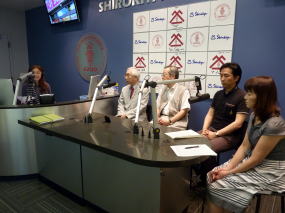
HICARE staff appearing on a local radio program to call for participation in the seminar
Results:
●The seminar intended for physicians was attended by many participants including physicians and nurses from within and without the Kuakini Health System, trainees from Japan, and clerical workers. Although it was conducted for only a short time, the participants actively asked questions. In addition, we explained to the president of the Kuakini Health System the activities of HICARE, particularly our training project, to seek cooperation in the dispatching of local physicians and other medical professionals as trainees.
●Medical students as well as professors at the University of Hawaii attended the seminar intended for medical students. The participants asked many questions after the lecture. Some students showed acute interest in our training project.
●The seminar intended for the general public was attended by A-bomb survivors, their family members, the general public, physicians and others. The audiences actively participated in a question-and-answer session, which continued past the scheduled finishing time.
●The staff of HICARE appeared on a local Japanese-language radio program explaining the activities of HICARE and our seminar to be held this time around. We were also interviewed for a local TV program. Thus, we were able to disseminate the activities of HICARE through the mass media.
●Through our activities mentioned above, we were able to achieve the aims of the seminar: to promote understanding and diffusion of medical care for A-bomb survivors; to enhance collaboration with local physicians; and to establish a framework for cooperation in dispatching local physicians to HICARE training.




